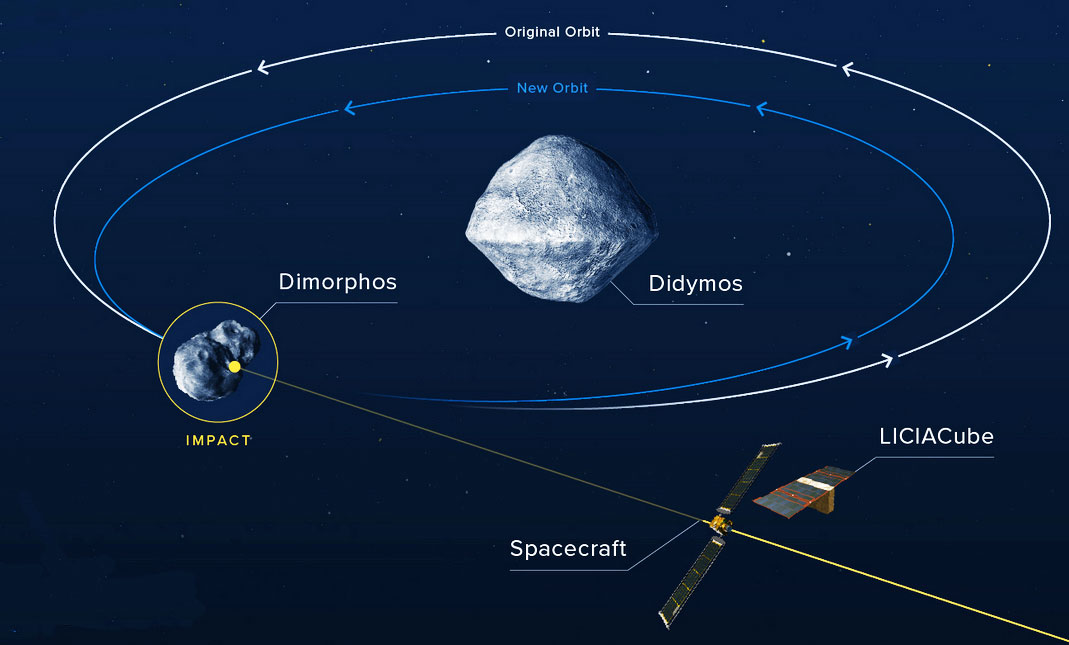|
Newsletter:
As described in our November 2020 newsletter, NASA is about to test a planetary defense
strategy that may ultimately protect Earth from asteroid impacts, such
as the devastating “K-T” event 66 million years ago in which 75% of all
animal and plant species, including the dinosaurs, became extinct.
While
such disasters happen very rarely, asteroids pose a continual threat to
our survival. NASA officials estimate there are 25,000 “large”
asteroids in our Solar System, of which we have found 8000.
Just
before Thanksgiving 2021, NASA will launch DART (Double Asteroid
Redirection Test) atop a SpaceX Falcon 9 rocket from Vandenberg Air
Force Base, near Santa Maria, California.
To be clear, this is only a test — no known asteroids currently threaten us.
NASA will test the kinetic impactor technique
by smashing DART into an asteroid to alter its trajectory. If done
well, even a small trajectory change can prevent an asteroid hitting
Earth. As our prior newsletter noted, a velocity change of 35mm/sec (1.4
inch/sec), occurring 1 year before an expected impact, should ensure
collision avoidance. And the sooner, the better — if we can change an
asteroid’s velocity X years before the expected impact, the required
velocity change is X times smaller, or alternatively, the same impact
can deflect an asteroid X times more massive.
Since a big enough asteroid could destroy most life on Earth, we really should confirm these calculations with actual tests.
The target of this test is Dimorphos, which like about 1/6th
of all asteroids has a partner, Didymos. The senior partner, Didymos is
about a half-mile (780m) wide and 100 times more massive than
Dimorphos, which is 520 feet (160m) wide and orbits Didymos in 11.9 hours. This binary system orbits the Sun in 2.1 years, but never crosses Earth’s orbit.
By comparison, the asteroid that killed the dinosaurs was about 7 miles wide.
NASA
has carefully chosen its target. Dimorphos is small enough to be
deflected measurably. Didymos’s much greater mass minimizes changes to
the binary system’s trajectory, which is not on a collision course with
Earth by a safe margin.
In
September 2022, DART will crash into Dimorphos as this NASA image
shows. The white curve is Dimorphos’ orbit around Didymos pre-impact.
The smaller blue curve is the orbit after DART hits Dimorphos head-on at
nearly 15,000 mph (6.6m/s). NASA hopes this reduces its orbit period by 10 minutes.

LICIA,
an accompanying satellite supplied by the Italian Space Agency, will
hitch a ride on DART, then hop off and witness the action. LICIA is an
acronym for Light Italian Cubesat for Imaging Asteroids.
DART
employs an internal guidance and navigation system to ensure optimal
impact. The thrust propelling DART is created by accelerating Xenon
ions, with electric power from large solar panels (20m2, 220sq-ft) that roll out after launch.
If all goes well, the next step in planetary defense is creating greater punch.
Best Wishes,
Robert

November 2021
Note: Previous newsletters can be found on my website.
|